Menus
- The Japanese endurance Bimota based on Honda CBR900RR Fireblade
- 4 cylinders in line, 944 cm3, 177 hp, 163 kg
- Genesis
- Discovery
- Test
- Conclusion
The Japanese endurance Bimota based on Honda CBR900RR Fireblade
4 cylinders in line, 944 cm3, 177 hp, 163 kg
TSR Honda AC90M. Who does this name mean? Not many people or a few rare connoisseurs. But if I tell you Honda CBR 900 RR Fireblade, there everyone follows. Well, it’s the same bike, or almost. Explanations and test of course, of a very special motorcycle victorious in endurance.
But let’s start with TSR. Third in the FIM EWC World Endurance Championship in 2020, the F.C.C. TSR Honda France stood out last season by winning the 24 Heures Motos. As competition prepares to resume on the Bugatti Le Mans circuit, the Mazakasu Fujii team, already crowned during the 2017/2018 season, fully intends to return to the top this year with Mike di Meglio, Josh Hook and Yuki Takahashi.
Because long before entering the full-time championship, the TSR Honda team had multiplied its successes in endurance racing since its debut at the Suzuka 8 Hours in 1990, forging its legend over three decades of competition. It must be said that the team made a sparkling debut at Suzuka, before disappearing for a few years to focus on the development of its motorcycles for the X-Formula category in Japan and return to the 8 hours of Suzuka in 2003 with a first podium. , followed by seven others, including three victories in 2006, 2011 and 2012. In 2017-2018, the team won the two 24-hour races at Le Mans and the Bol d’Or for its first full season and became par the same occasion the first Japanese team champion of the EWC world. But it’s X-Formula that it has its roots.
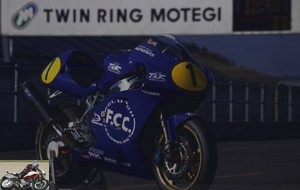 Test of the Honda AC90M from team F.C.C. TSR
Test of the Honda AC90M from team F.C.C. TSR
Genesis
Anyone who visited the Bol d’Or in the ’70s and’ 80s remembers the wide variety of motorcycles on the grid, from factory prototypes to special preparations, each with its own specificities and engineering innovations. . We are talking here about motorcycles like the ELFe with its factory Honda engine and the first carbon brakes used on a motorcycle, the Laverda V6, the Honda NR750 with oval pistons, the Yamaha TZ750 2-stroke, the strange British Nessie with steering hub, Fior Yamaha, Kawasaki Offenstadt, Sidemm-Benelli with monocoque frame … To all these original machines we had to add the more conventional superbikes, which generally fought for victory, like the Kawasaki Godier & Genoud, Suzuki Bakker, Honda Japauto, etc..
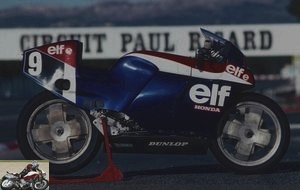 Endurance has always been a great development ground for motorcycles, as here for the ELFe
Endurance has always been a great development ground for motorcycles, as here for the ELFe
Nowadays, as the design of Japanese sports cars has become the norm, it makes sense that Endurance regulations have leaned on them to make it possible to buy and prepare a motorcycle without having to design it from A to Z. But in addition to encouraging innovation, it makes sense to allow manufacturers to use this discipline to develop new generation motorcycles, as has been the case for decades in the Suzuka 8H, the Bol d’Or and the 24H Motos. This is what Ducati did by registering its Desmoquattro prototype for the Bol 86, a year before its appearance in the form of the 851 and the 9 WorldSBK titles, or as MV Agusta did throughout 2001 with the proto of the future F4 1000. Hence the presence of the Experimental class which still runs alongside traditional machines and where we find in particular the sports steering hub JBB Metiss, although it will not run this year at the Mans for the first time in 20 years.
Mazakasu Fujii therefore created the F.C.C. TSR Honda as an endurance team by building special versions of the Honda CBR900RR Fireblade and entering them in the X-Formula class at Suzuka. This category was created in 1997 to flesh out the Japanese Superbike grids, but was later adopted by the 8-hour sprint race interspersed with pit stops which is the most important event on the Japanese manufacturers’ calendar..
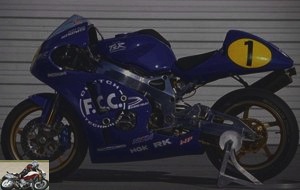 The 2001 TSR Honda AC90M
The 2001 TSR Honda AC90M
This variant of the old TT Formula 1 regulations allowed all motorcycles up to 1,300 cc regardless of the number of cylinders (hence the Sundance Harley and the Yoshimura Hayabusa) and exempted participants from homologation requirements in favor of ‘a redemption rule: any team involved in the race could claim one of the first six motorcycles to arrive for 3.5 million yen (around 140,000 francs at the time). This obviously discouraged the factory prototypes from finishing ahead, but not participating and also encouraged the construction of many preps or sports of small series by recognized manufacturers like Moriwaki, Over, Yoshimura and TSR.
It’s not necessarily very well known outside of Japan, but for many years after it opened in 1998, the Twin Ring Motegi, Honda’s other circuit, hosted another great endurance race in September, six weeks ago. after Suzuka. The Motegi 7-Hours was an extremely followed race within the framework of the national title and which took up the rules of X-Formula, attracting a host of machines developed by the best preparers in the country, like the Over and Moriwaki who were / are projects of the racing departments of the 4 Japanese manufacturers. This is what made the three consecutive victories of the TSR Hondade 1999 to 2001 particularly important. In the hands of Jurgen van den Goorbergh and Jun Maeda, the Honda won in X-Formula but also finished 15th in the scratch at Suzuka and the TSR Honda AC90M was clearly a very special motorcycle. Driving it on a sunny autumn afternoon on the same track where it had forged its legend was all the more crisp.
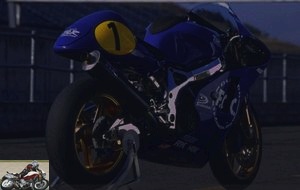 The AC90M allowed the TSR team to win the Motegi 7h three times
The AC90M allowed the TSR team to win the Motegi 7h three times
TSR means Technical Sports Racing, a company founded by Mazakasu’s father Fujii who was once a Honda test rider in the 1960s before supplying prep parts for the manufacturer’s motorcycles, a company that has grown to become one of the most reputable brands from Japan in this area, still exclusively for Honda.
Discovery
These three successes on the double ring of Motegi, it is with the Honda AC90M that the TSR obtained them. The AC90M was based on a 1998 Honda CBR900RR Fireblade that had a lot of stress on the chassis and engine, before dressing it in a more aerodynamic full fairing with an Aprilia-style saddle intended to reduce the trainee.
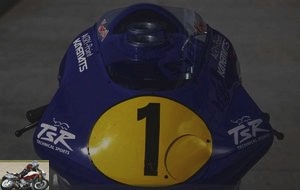 The Honda is equipped with a full fairing with full coverage.
The Honda is equipped with a full fairing with full coverage.
The stock Honda 918cc engine was bored 1mm up to 72 x 58mm to achieve a displacement of 944cc with new Cosworth pistons mounted on titanium Pankls rods and a rebalanced stock crankshaft, but not lightened. Oil circulation was not a problem, even for endurance, according to R&D chief Nori Shimizu. The original valves and springs have been retained and fitted to the new Erion Racing camshafts and Keihin Flatside 41mm carburetors. TSR originally envisioned oversized valves, but backtracked upon realizing that this would impact fuel mileage, a crucial point in Endurance..
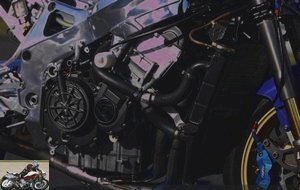 The engine of the CBR900RR was increased to 944 cm3
The engine of the CBR900RR was increased to 944 cm3
The ignition is based on the original Honda CDI and although the CBR900 gearbox has been fitted, it features a longer second gear from the HRC Racing Kit. Above all, the clutch, still in an oil bath, is anti-dribble and produced by long-time team sponsor the F.C.C., as in Fuji Clutch Company. Equipped with its in-house carbon exhaust, the engine thus tuned delivers 177 shaft horsepower at 12,200 rpm, which is equivalent to 162 wheel horsepower according to Shimizu-san, with a maximum speed of 12,800 rpm..
The endurance TSR’s racing chassis still relies on the aluminum perimeter frame of the 98 Fireblade, but it has been heavily polished and topped off with reinforcements at the steering column and swingarm pivot for more. of rigidity. The caster angle has been reduced from 24 ° to 22.5 ° and the front damping entrusted to a fully adjustable 43mm WP inverted fork specially designed in Austria for the TSR and modified internally by the team. The same goes for the Nissin special four-piston calipers biting 310mm floating discs adapted to allow a quicker change of the 17 "Marchensini front wheel with Michelin pavement during pit stops.
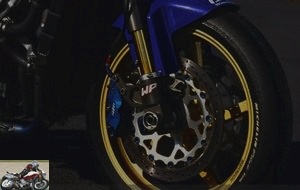 The TSR AC90M is braked by Nissin 4 piston calipers
The TSR AC90M is braked by Nissin 4 piston calipers
The weight is incredibly low at 163 kg dry, just a kilo above the WSBK weight limit that X-Formula motorcycles had to adhere to. The swingarm made of a special alloy is strongly reinforced and has a specific TSR linkage with a fully adjustable WP shock absorber which, following the various modifications, reduces the wheelbase by 15 mm compared to the stock 1,390 mm. All of these modifications led the TSR to name the project AC90M, only their own frames being numbered in this way..
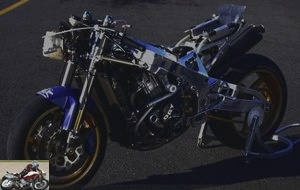 The chassis remains very light since the bike claims only 163 kg without gasoline
The chassis remains very light since the bike claims only 163 kg without gasoline
But the new design was enough to prevent the race bike from competing in EWC. It didn’t help that the TSR subsequently produced an all-new, stiffer and lighter version of its chassis for the road-approved limited edition AC91M in 2002, because production was only planned for 30 copies, on request and adapted specifically to each client. Yes, it’s a bit of a Japanese Bimota !
Test
The chance to drive the AC90M on the Motegi Grand Prix track underlined just how powerful the Honda TSR was, while still remaining extremely maneuverable: I could imagine how it could have become an ideal sports car in the long run, capable of ” evolve on slow circuits as well as on the fastest ones. It was incredibly beautiful and huge when I first saw it parked in the Pit Lane, but it was an optical illusion mostly created by the massive 24-liter fuel tank, up six liters per compared to the standard Fireblade.
 At first glance, the AC90M seems much bigger than the stock Fireblade
At first glance, the AC90M seems much bigger than the stock Fireblade
The geometry changes and the larger front wheel combine to make the steering even sharper and certainly more predictable than I expected. It’s surprisingly easy to rock from side to side in the Twin Ring baffles, even with the heavy fuel load I had soared with. But you never forget that this is a big bike, with a feeling of breadth amplified by the efficient fairing that covers the hands well in anticipation of the mid-summer typhoons in Japan or the biting cold of a 24 hour race in France in April. Folding behind him offers reasonable protection in the Motegi straight line, although the large tank lets the top of the helmet take to the air at high speed..
The chassis modified by the TSR team is very stable, both when accelerating out of a corner and under heavy braking, such as downhill at the end of the rear straight, where a motorcycle with a front wheel weight bias as extreme as here (56/44%) might normally start to move under mass transfer as you approach the hairpin bend. This is not the case here, however – and the AC90M also holds its course well under strong acceleration while still leaning on the angle – it does not push the front wheel, even with a full tank..
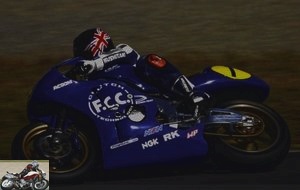 The sportswoman is very stable in curves
The sportswoman is very stable in curves
The only thing I hadn’t really cared about about the handling of the TSR was the very hard, unresponsive suspension setup the engineers had chosen for my test drive. This causes a slight dribble in the left hand after the upper chicane, then again out of turn one, the two places where you find the bumps left by the cars. So while it performs very well on smooth track surfaces, the AC90M is too stiff to cope with flaws. After riding the factory Kawasaki Superbike with the same WP fork, I know it could perform better than that. Perhaps this choice is deliberate, to account for the full loads of fuel the bike has to carry over and over again, but even on a smooth circuit like Motegi, that was overkill. The fork damping is also too stiff on the rebound, but I’m afraid that in Japan, where track time is always of the essence, we won’t have time to start playing with that..
Having ridden other prepared Fireblades of the same vintage as this one, from the 1998 stock TT winner Jim Moodie delivering 123 hp for 179 kg, to the RS Performance with which Steve Plater won the British Powerbike the same year ( 146 hp for 167 kg), I had some benchmarks for the Honda TSR of 162 hp and 163 kg. And in all fairness this is definitely the best I’ve driven. Not only does it handle and behave fairly well, although quite rough, the engine has available power almost from idle, enough in any case to lift the front wheel out of a corner in the three lower gears. It would also work in first gear if this ratio was not too low to be used on the track, except in the pit lane after a refuel..
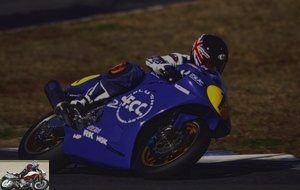 The 162 hp 4-cylinder shows its fangs at low revs
The 162 hp 4-cylinder shows its fangs at low revs
Surprisingly, even for 2002 there is no poweshifter installed, which is all the more unfortunate that the TSR had one in its catalog at the time! While the gear change is rather stiff and slow, it also feels quite positive with a reassuring shift when the higher gears are engaged. However, by speeding up the gear changes one can quickly skip a gear like I did at the start of my test until I learn to make concessions. This is how I also discovered that the engine seemed to run at more than 13,000 revolutions without visible damage and without the slightest trace of a breaker! Hmm…
Second gear is fine tuned, as you need it four times per lap at Motegi and using it out of the chicane or one of the tighter inside corners, like at the top chicane, provides blazing acceleration that makes me stand on the footrests to keep the front wheel on the ground as the fuel load has eased. The shortshifting (up a gear before the optimal speed) to a little more than 10,000 at the exit of the last chicane allows to put the engine in full in the torque curve, which allows to benefit from it all along before accelerate out.
 Fortunately the engine brake is present, because the Nissin calipers are a bit weak
Fortunately the engine brake is present, because the Nissin calipers are a bit weak
At the end of the back straight, by braking as hard as possible on this bike which seems heavier to me than it really is, I am happy to use second gear to access essential engine braking, without have to fear a dribble thanks to the slip clutch. I really need the little residual engine braking that TSR left behind, as the Nissin brakes aren’t the best unlike the six-piston ones from the same manufacturer that have always impressed me on racing Superbikes. These four-piston calipers never had the same bite as their counterparts, but at least they perform reasonably well initially, even with a full load of fuel. But after half an hour they start to fade. The three successive brakes at the top of the circuit and especially the last one at the bottom of the straight line must have started them seriously, failing to make me finish my race in the gravel trap. whoops !
Conclusion
After this hitch, I put things in perspective and I no longer had a near-accident. The TSR Honda is a motorcycle that we find easy to put in a "rhythmic" ride and it is a major attribute for an endurance sportswoman. It is incredibly fun to drive once you take note of the things to pay attention to and these qualities are proven for long distances as evidenced by its winning streak at the 7 Hours of Motegi..
Good training for EWC races by Fujii-san !
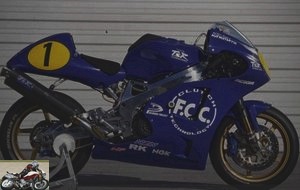 TSR Honda AC90M
TSR Honda AC90M
Strong points
- Precision
- Motor
- Homogeneity
- Anti-dribble clutch
Weak points
- Stiff suspensions
- Braking
The technical sheet of the TSR Honda AC90M
Related articles
-
The last of the line The ultimate expression of ELF’s motorcycle design philosophy was the ELF5 , itself an evolution of the unsuccessful ELF4 and which…
-
Sports test Chevallier Honda RS500
Against all odds V3 at 90 °, 499 cm3, 125 hp, 116 kg dry Beating the Japanese factory teams by winning Grand Prix with motorcycles you yourself built in…
-
Road bike 173 horses Presented in early 2010 as the synthesis of Honda know-how, both mechanically, qualitatively and technologically, the VFR 1200 did…
-
Waiting for the new Hornet… No, the CB 650 F is not the replacement for the Hornet. Healthy, easy and fast enough, it is intended primarily for…
-
GT-Cruiser of the 3rd type The winged builder keeps up his ideas and keeps revisiting the contemporary bagger style. After the F6B and very soon F6C,…
-
The latest generation of CB 500s delighted “young licensees” for over a decade. Her replacement was therefore expected at the turn, crystallizing the…
-
Honda CMX 500 Rebel S motorcycle test
Little rebellious bobber In-line twin, 471 cm3, 45 hp at 8,500 rpm, 44.6 Nm at 6,000 rpm, 190 kilos, € 6,299 Rather bi or 4? It’s that the couple is…
-
Japanese Spice Choper. When Honda introduced the Fury in 2009, no one believed it … what could have prompted a Japanese brand to create such an extreme…
-
497 cc, 82 hp, 190 km / h, the first mass-produced turbo motorcycle A Power Ranger look for an expensive but efficient grand tourer The turbo , it’s a…
-
Honda VFR 1200 DCT Automatic Test
The automatic soul Disappointing in a traditional gearbox, it seems that the VFR 1200 with double clutch takes all its measure with the automatic…